 |
|
|
Naming
this new site the indigenous "COP-5 Forest," Klaus Töpfer [front]
emphasized the need to make peace with nature. Lásló Miklós [back
row, far left] wished that the number of plants and trees planted
could exceed if not equal those cut and eaten. |
|
Glenn
Denning stressed the significance of managing trees' multi-faceted
features and benefits. He said the new COP-5 Forest symbolized the
growing partnership between UNEP and ICRAF whose grounds it straddles.
|
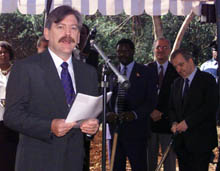 |
|
|
Francis
Nyenze expressed his wish that the COP-5 forest conserve rare and
valuable trees indigenous to Kenya and sensitize his country's and
other citizens about local biodiversity. |
|
|
Opening
Plenary
|
|
|
COP-5
participants were entertained by the Kenyatta University Choir prior
to the opening of the meeting.
|
 |
|
|
 President of COP-4, László Miklós (Slovakia), welcomed delegates
and overviewed the CBD's achievements during the intersessional period,
particularly the Cartagena Protocol, SBSTTA's progress, the ISOC,
the Panel of Experts on Access and Benefit-Sharing and the Working
Group on Article 8(j).
President of COP-4, László Miklós (Slovakia), welcomed delegates
and overviewed the CBD's achievements during the intersessional period,
particularly the Cartagena Protocol, SBSTTA's progress, the ISOC,
the Panel of Experts on Access and Benefit-Sharing and the Working
Group on Article 8(j). |
 Hamdallah Zedan, Executive Secretary of the CBD, noted that
the intersessional meetings and activities on biosafety, benefit-sharing,
traditional knowledge, dryland and agricultural biodiversity, and
review of the financial resources and mechanism have laid a solid
foundation for the CBD's future development. He also noted the forthcoming
ten-year review for the implementation of Agenda 21 and associated
conventions.
Hamdallah Zedan, Executive Secretary of the CBD, noted that
the intersessional meetings and activities on biosafety, benefit-sharing,
traditional knowledge, dryland and agricultural biodiversity, and
review of the financial resources and mechanism have laid a solid
foundation for the CBD's future development. He also noted the forthcoming
ten-year review for the implementation of Agenda 21 and associated
conventions. |
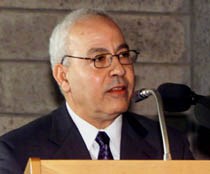 |
|
|
 Klaus Töpfer, UNEP Executive Director, noted challenges facing
Africa, including conflicts and poverty, and encouraged investment
in sustainable development rather than in managing conflicts once
they arise. He urged awareness of the relationship between poverty
and biodiversity. He lauded the finalization of the Cartagena Protocol
and noted the signing ceremony to be held on 24 May.
Klaus Töpfer, UNEP Executive Director, noted challenges facing
Africa, including conflicts and poverty, and encouraged investment
in sustainable development rather than in managing conflicts once
they arise. He urged awareness of the relationship between poverty
and biodiversity. He lauded the finalization of the Cartagena Protocol
and noted the signing ceremony to be held on 24 May. |
 Daniel arap Moi, President of Kenya, welcomed COP-5 delegates
to Nairobi and noted that biodiversity is a vital resource for socioeconomic
development and for the long-term well-being of communities. He
stressed that the COP should focus on the development of a work
programme for the implementation of the Cartagena Protocol, access
to genetic resources and benefit-sharing (ABS), biodiversity in
dryland ecosystems and sustainable use.
Daniel arap Moi, President of Kenya, welcomed COP-5 delegates
to Nairobi and noted that biodiversity is a vital resource for socioeconomic
development and for the long-term well-being of communities. He
stressed that the COP should focus on the development of a work
programme for the implementation of the Cartagena Protocol, access
to genetic resources and benefit-sharing (ABS), biodiversity in
dryland ecosystems and sustainable use. |
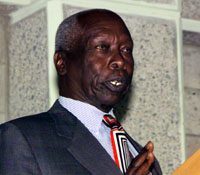 |
|
|
Immediately after his speech, President Moi signed the Cartagena Protocol,
making Kenya its first signatory. |
|
|
Plenary
|
|
|
Outgoing
COP President Miklós passes on the torch - and the gavel - to newly-elected
COP-5 President Francis Nyenze, Kenyan Minister of Environment and
Natural Resources
|
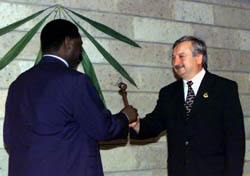 |
|
|
COP-4
President Miklós nominated Francis Nyenze, Minister of Environment
and Natural Resources of Kenya, as the President of COP-5, who was
then elected by acclamation. Nyenze then introduced the provisional
agenda (UNEP/CBD/COP/5/1). |
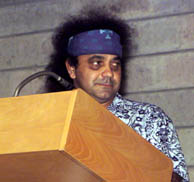  The fifteenth GLOBAL BIODIVERSITY FORUM summarized its key conclusions,
including that the COP should: recommend full integration of monetary
and non-monetary goods and services of biodiversity into poverty
alleviation strategies; ensure national biodiversity strategies
and action plans take full account of the needs of the poor; ensure
full and effective participation of indigenous peoples in the CBD's
work on ABS; ensure that resource country measures are complemented
by those of user countries; and adopt strong work programmes on
agrobiodiversity and drylands.
The fifteenth GLOBAL BIODIVERSITY FORUM summarized its key conclusions,
including that the COP should: recommend full integration of monetary
and non-monetary goods and services of biodiversity into poverty
alleviation strategies; ensure national biodiversity strategies
and action plans take full account of the needs of the poor; ensure
full and effective participation of indigenous peoples in the CBD's
work on ABS; ensure that resource country measures are complemented
by those of user countries; and adopt strong work programmes on
agrobiodiversity and drylands. |
|
|
 SBSTTA-4 Chair A.H. Zakhri (Malaysia) introduced the meeting's
report and recommendations (UNEP/CBD/COP/5/2). He stated that SBSTTA-4
addressed: SBSTTA's programme of work; terms of reference for expert
groups; the GTI; status and trends of terrestrial biodiversity; alien
species; technologies for plant gene expression; environmental impact
assessments; and sustainable use, including tourism. He also noted
SBSTTA's improved effectiveness in bridging the gap between researchers
and policy-makers.
SBSTTA-4 Chair A.H. Zakhri (Malaysia) introduced the meeting's
report and recommendations (UNEP/CBD/COP/5/2). He stated that SBSTTA-4
addressed: SBSTTA's programme of work; terms of reference for expert
groups; the GTI; status and trends of terrestrial biodiversity; alien
species; technologies for plant gene expression; environmental impact
assessments; and sustainable use, including tourism. He also noted
SBSTTA's improved effectiveness in bridging the gap between researchers
and policy-makers. |
 SBSTTA-5 Chair Cristián Samper (Colombia) noted SBSTTA-5's report
and recommendations (UNEP/CBD/COP/5/3). He drew attention to the
meeting's priority issues: the programme of work for dryland biodiversity;
agricultural biodiversity; the ecosystem approach; biodiversity
indicators; sustainable use; guidelines for the second national
reports; and ad hoc technical expert groups. He also proposed strengthening
SBSTTA's work, through: streamlining its agenda; intersessional
mechanisms for scientific assessments; better use of the CHM; and
strengthened relationships with other conventions and international
scientific processes.
SBSTTA-5 Chair Cristián Samper (Colombia) noted SBSTTA-5's report
and recommendations (UNEP/CBD/COP/5/3). He drew attention to the
meeting's priority issues: the programme of work for dryland biodiversity;
agricultural biodiversity; the ecosystem approach; biodiversity
indicators; sustainable use; guidelines for the second national
reports; and ad hoc technical expert groups. He also proposed strengthening
SBSTTA's work, through: streamlining its agenda; intersessional
mechanisms for scientific assessments; better use of the CHM; and
strengthened relationships with other conventions and international
scientific processes. |
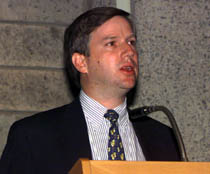 |
 Ambassador Philémon Yang (Cameroon), Chair of the Bureau of
the open-ended ad hoc Intergovernmental Committee for the Cartagena
Protocol (ICCP), introduced the ICCP's draft work plan prepared
by the Bureau, and invited the COP to endorse it. He said the proposed
work plan addresses issues to be considered at the first meeting
of the Parties to the Protocol (MOP-1), and activities central to
its operation.
Ambassador Philémon Yang (Cameroon), Chair of the Bureau of
the open-ended ad hoc Intergovernmental Committee for the Cartagena
Protocol (ICCP), introduced the ICCP's draft work plan prepared
by the Bureau, and invited the COP to endorse it. He said the proposed
work plan addresses issues to be considered at the first meeting
of the Parties to the Protocol (MOP-1), and activities central to
its operation.
|
 COP-4 President Miklós introduced the ISOC's report (UNEP/CBD/COP/5/4),
which concentrates on two main tasks: preparation for and conduct
of COP meetings; and further work on ABS with a focus on the Expert
Panel's.
COP-4 President Miklós introduced the ISOC's report (UNEP/CBD/COP/5/4),
which concentrates on two main tasks: preparation for and conduct
of COP meetings; and further work on ABS with a focus on the Expert
Panel's.
|
|
|
Side event: Unveiling of the new CMS poster
|
|
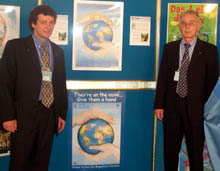 The
Convention on Migratory
Species (CMS) Secretariat inaugurated a poster exhibition
created by Bonn school students. Arnulf Müller-Helbrecht, CMS
Executive Secretary [right] and Suhel Al-Janabi, CMS German
Liaison Officer [left], presented the official CMS poster
and heard statements by dignitaries such as Klaus Töpfer, Executive
Director of UNEP and Hamdallah Zedan, CBD Executive Secretary. The
Convention on Migratory
Species (CMS) Secretariat inaugurated a poster exhibition
created by Bonn school students. Arnulf Müller-Helbrecht, CMS
Executive Secretary [right] and Suhel Al-Janabi, CMS German
Liaison Officer [left], presented the official CMS poster
and heard statements by dignitaries such as Klaus Töpfer, Executive
Director of UNEP and Hamdallah Zedan, CBD Executive Secretary.
In
other CMS-related news, Kenyan President Daniel arap Moi signed
the CMS on behalf of his country, immediately before the opening
of CBD COP-5.
|
|
|
Side event: The Sunshine Project's presentation on "Agent
Green" |
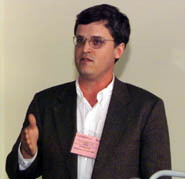 Ed
Hammond [ehammond@sunshine-project.org]
provided background information on the USA's experiments with fungi
intended to kill narcotic plants, including coca, opium poppy and
cannabis. Targets for the fungi include narcotic crop-producing
countries in Asia and Latin America. Hammond noted the fungi would
be dropped from airplanes, recalling the use of Agent Orange during
the Vietnam War, thus the term "Agent Green." He opposed the experimental
fungi, noting they could provide a threat to human health and endangered
species, have not been tested on wild relatives of the plants, and
are highly persistent (some staying in exposed soils for 30 years)
and highly mobile through vectors including farm implements and
animals. He encouraged the COP to take action on this issue to avoid
a precedent that allows for the use of killing pathogens abroad
while the user country deems their use undesirable at home. He further
stressed that fungal pathogens are dangerous and, in some cases,
in violation of Article 8(j). Ed
Hammond [ehammond@sunshine-project.org]
provided background information on the USA's experiments with fungi
intended to kill narcotic plants, including coca, opium poppy and
cannabis. Targets for the fungi include narcotic crop-producing
countries in Asia and Latin America. Hammond noted the fungi would
be dropped from airplanes, recalling the use of Agent Orange during
the Vietnam War, thus the term "Agent Green." He opposed the experimental
fungi, noting they could provide a threat to human health and endangered
species, have not been tested on wild relatives of the plants, and
are highly persistent (some staying in exposed soils for 30 years)
and highly mobile through vectors including farm implements and
animals. He encouraged the COP to take action on this issue to avoid
a precedent that allows for the use of killing pathogens abroad
while the user country deems their use undesirable at home. He further
stressed that fungal pathogens are dangerous and, in some cases,
in violation of Article 8(j). |
|
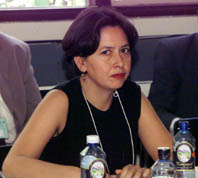 Susana
Pimiento [spimiento@sunshine-project.org]
urged the COP to: adopt a resolution establishing a clear precedent
that the development of any pathogen to deliberately kill any cultivated
crop is contrary to the Convention's objectives; assess the potential
impact of narcotic plant pathogens on agriculture, particularly
their potential threat to soil ecology and pollinators, under the
CBD programme on agro-biodiversity; analyze the use of narcotic
crop pathogens in light of the CBD provisions related to biotechnology,
including the Biosafety Protocol; and request the Executive Secretary
to urgently communicate to the UN Commission on Narcotic Drugs,
prior to its March 2001 session, the concern of the Parties that
certain activities undertaken in international eradication programmes
may raise questions with respect to CBD Parties' commitments to
protect biodiversity and the biodiversity rights of indigenous peoples
and local communities. For more information on the Sunshine Project,
please visit http://www.sunshine-project.org/ Susana
Pimiento [spimiento@sunshine-project.org]
urged the COP to: adopt a resolution establishing a clear precedent
that the development of any pathogen to deliberately kill any cultivated
crop is contrary to the Convention's objectives; assess the potential
impact of narcotic plant pathogens on agriculture, particularly
their potential threat to soil ecology and pollinators, under the
CBD programme on agro-biodiversity; analyze the use of narcotic
crop pathogens in light of the CBD provisions related to biotechnology,
including the Biosafety Protocol; and request the Executive Secretary
to urgently communicate to the UN Commission on Narcotic Drugs,
prior to its March 2001 session, the concern of the Parties that
certain activities undertaken in international eradication programmes
may raise questions with respect to CBD Parties' commitments to
protect biodiversity and the biodiversity rights of indigenous peoples
and local communities. For more information on the Sunshine Project,
please visit http://www.sunshine-project.org/
|
|
|
Side event: GEF/BPSP Consultation
|
|
The Global
Environmental Facility Biodiversity Planning Support Programme
(BPSP) held a stakeholder consultation facilitated by Ken Creighton
[below, righthand side], UNDP-GEF BPSP coordinator. UNEP
and UNDP implement this multi-donor initiative that supports National
Biodiversity 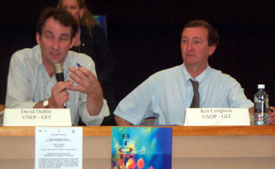 Strategies
and Action Plans preparation and implementation and provides specialized
biodiversity planning expertise aimed to facilitate intra-regional
information exchange among national planners. Strategies
and Action Plans preparation and implementation and provides specialized
biodiversity planning expertise aimed to facilitate intra-regional
information exchange among national planners.
David Duthie,
UNEP-GEF BPSP Coordinator [david.duthie@unep.org,
on the left], highlighted the following BPSP activities: biodiversity
information gathering, exchange and dissemination via list-servers
and newsletters; the development of "best practice" experiences
pertinent to issues emerging from National Reports and COP guidance
on biodiversity mainstreaming, incentive measures and harmonizing
the implementation of CBD and biosafety objectives with other
biodiversity-related conventions; UNEP-led thematic workshops
focusing on specific CBD objectives in the context of cross-sectoral
national planning; UNDP-led regional experience exchange workshops;
and publications such as Biodiversity Strategies and Action
Plans: Lessons from Asia edited by Jeremy Reid for IUCN and
BPSP.
Regional
collaborators and NGO partners spoke on biodiversity information-exchange
activities and practical experiences from Africa, the Arab States,
Asia, Pacific Island Countries, Central and Eastern Europe, Small
Island States and Latin America. Along with participants, they
highlighted the procedural challenges posed by coordinating and
mainstreaming biodiversity-related efforts across sectors.
|
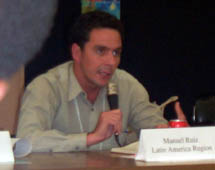 Manual
Ruiz, Sociedad por los Derechos Ambientales (SPDA) of Peru [left],
said that developing systematic yet flexible methods for biodiversity
strategies and plans required further reflection as do approaches
for tackling the economic and incentive aspects of biodiversity
conservation, access and benefit sharing. Manual
Ruiz, Sociedad por los Derechos Ambientales (SPDA) of Peru [left],
said that developing systematic yet flexible methods for biodiversity
strategies and plans required further reflection as do approaches
for tackling the economic and incentive aspects of biodiversity
conservation, access and benefit sharing.
Participant
Tony J. Onugu, Bioresources Development and Conservation Programme,
suggested that BPSP collaborate more extensively with a wider
group of NGOs to ensure that national governments develop biodiversity
plans and strategies with civil society in conjunction with the
appropriate national and international expertise. Sidestepping
this concern somewhat, BPSP coordinators suggested that NGOs participate
through the GEF medium-sized and small-sized grant programmes.
For more information: http://www.undp.org/bpsp/
|
|
|
Side event: Crucible Group II book release
|
|
|
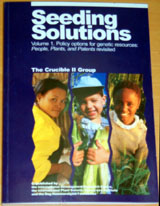 The
Crucible Group launched its new book entitled "Seeding Solutions:
Policy Options for Genetic Resources." The book's subtitle,
"People, Plants and Patents Revisted", refers to an earlier
1995 Crucible Group publication that explored the genetic resource/intellectual
property nexus. "Seeding Solutions" is Volume I of a two part series.
Volume II will provide a menu of legislative options regarding access
to genetic resources, the protection of indigenous knowledge and
the promotion of innovation in classical plant breeding and in biotechnology. The
Crucible Group launched its new book entitled "Seeding Solutions:
Policy Options for Genetic Resources." The book's subtitle,
"People, Plants and Patents Revisted", refers to an earlier
1995 Crucible Group publication that explored the genetic resource/intellectual
property nexus. "Seeding Solutions" is Volume I of a two part series.
Volume II will provide a menu of legislative options regarding access
to genetic resources, the protection of indigenous knowledge and
the promotion of innovation in classical plant breeding and in biotechnology.
Alejandro
Argumedo, Indigenous Peoples' Biodiversity Network; Mita Nabek,
African Center for Technology Studies; Chusa Gines, International
Development Research Center of Canada; Nora Olembo, Kenya's Industrial
Property Office and Susan Bragdon, International Plant Genetic Resources
Institute spoke on behalf of the Crucible Group which includes over
45 experts holding different perspectives on food security, genetic
resources and intellectual property. They emphasized the differences
of opinion regarding the ownership and control of genetic resources,
whether or not and to what extent biological materials should be
subject to intellectual property claims and how biodiversity benefits
should be shared. For some, the primary concern is financial or
trade-related. For others, the issue relates directly to food security,
human rights and sustainable agriculture. For others, the issue
is one of linking development to biodiversity conservation and environmental
sustainability.
For
more information on the Crucible Group II and their book, contact
Michael Halewood [mhalewood@idrc.ca]
or visit the IDRC web site at [http://www.idrc.ca/books/725.html]
(some portions of the book available on-line from this page).
More information is to be had in IDRC's Reports
Online.
|
|
|
Side event: Diversity of the Cultures of Our Lives and Our
Foods
|
|
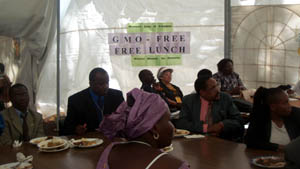 A
GMO-free indigenous Kenyan lunch dialogue, entitled "Diversity of
the Cultures of Our Lives and Our Foods," was hosted by the Kenya
Center for Indigenous Knowledge Systems and By-products (CIKSAP)
and Diverse Women for Diversity (DWD). A
GMO-free indigenous Kenyan lunch dialogue, entitled "Diversity of
the Cultures of Our Lives and Our Foods," was hosted by the Kenya
Center for Indigenous Knowledge Systems and By-products (CIKSAP)
and Diverse Women for Diversity (DWD).
Monica Opole,
CIKSAP Coordinator [left], emphasized the importance of developing
a culture of sharing regarding: indigenous, non-GMO agrobiodiversity
innovation and knowledge; biodiversity materials for feeding and
healing; culturally significant uses of indigenous biodiversity;
and circumventing the privatization and modern biotech engineering
of life forms.
Christine
von Weizsacker, ECOROPA Germany [center right], said the
potential scientific and cultural risks of GMOs are significant,
so "don't eat them before we know more" and "just because it is
from a lab does not means it is healthy or 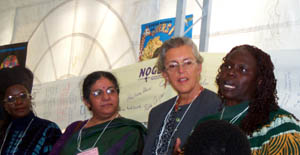 superior." superior."
Vandana
Shiva, Research Foundation for Science Technology and Ecology in
India [center left], highlighted her institution's battle
to promote the neem tree as a pesticide alternative and get the
neem patent rejected. She stressed that GMOs are a crazy option
since 1) they do not provide as much iron for anemic women or vitamin
A for blind children as do indigenous greens, and 2) the loss of
sacrificed nutrition resulting from GMO and green revolution agriculture
destruction of so-called inferior Southern indigenous agrobiodiversity
is rarely considered.
Wantari
Mathai, Kenya Greenbelt Movement [right], stressed that diversity
includes agriculture and people's identity reflected in what they
eat and grow. Hence, destroying culture also means destroying biodiversity.
She lamented the demise of indigenous Kenyan trees as a result of
their declining popular use, particularly in light of colonial bas
of local beer brewing using the Kenyan sausage tree and of local
Kenyan deities worshipped in large wild fig trees. She called for
democracy and environmental rights to forests, open spaces, clean
and air and water for the Kenyan and all people.
For
more information, contact Monica Opole of CIKSAP at [ciksap@nbnet.co.ke]
or Salini Bhutani of DWD, [halinibhutani@hotmail.com]
or visit the DWD web site at [http://www.vshiva.org/]
(follow the DWD link).
|
IN
THE BREEZEWAYS
 As delegates geared up for substantive discussions at COP-5, the
breezeways buzzed over what the key areas of debate might be. Along
with talk of how access to genetic resources and its sub-items would
be addressed, discussion also arose over the Cartagena Protocol
and which Parties would and would not sign during the meeting. The
debate engendered over the ICCP's work plan had some delegates wondering
whether the implementation of the Protocol would prove as difficult
as its negotiation.
As delegates geared up for substantive discussions at COP-5, the
breezeways buzzed over what the key areas of debate might be. Along
with talk of how access to genetic resources and its sub-items would
be addressed, discussion also arose over the Cartagena Protocol
and which Parties would and would not sign during the meeting. The
debate engendered over the ICCP's work plan had some delegates wondering
whether the implementation of the Protocol would prove as difficult
as its negotiation.
Right:
at the UN compound at Gigiri, buildings are not separated
by closed corridors, instead they are linked by open breezeways.
|
|